The pilgrimage site of Rampurva is uniquely significant because this is only place where Emperor Ashok chose to construct two Dhamma Stambha (twin Ashokan Pillars). The Ashokan pillars at this site are believed to commemorate Buddha’s renunciation. This is where at the bank of river Anoma (now called Harbora) Siddhartha exchanged his royal robes for an ascetic’s dress and chopped off his elegant hair locks and embarked on the path of search of knowledge in the forests of Champaran. There are indications that Rampurva could well be the actual site of Kushinara where Lord Buddha attained parinirvana and was cremated which seems to corroborate why Emperor Ashoka held this site to be uniquely significant. It is suggested that Ashoka had commemorated the spot of parinivana with a pillar. Another pillar, 300 paces apart marked the place of the Buddha’s cremation”.
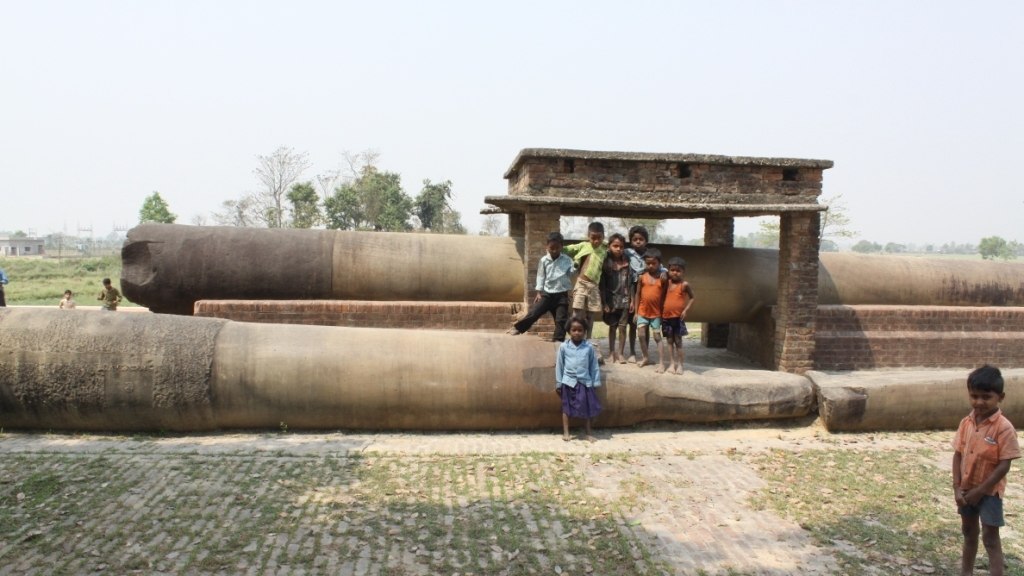
| IMPORTANCE OF THE PILGRIMAGE SITE |
| 1. Of thousands of places where Emperor Ashoka constructed monuments, the pilgrimage site of Rampurva is unique because this is only place where he chose to construct two Dhamma Stambha (twin Ashokan Pillars) standing just 300 meters apart, one with the lion capital and the other with the bull capital. |
| 2. Ashokan pillars at this site are believed to commemorate Buddha’s renunciation. This is where at the bank of river Anoma (now called Harbora) Siddhartha exchanged his royal robes for an ascetic’s dress and chopped off his elegant hair locks and embarked on the path of search of knowledge in the forests of Champaran. |
| 3. There are indications that Rampurva could well be the actual site of Kushinara where Lord Buddha attained parinirvana and was cremated which seems to corroborate why Emperor Ashoka held this site to be uniquely significant. It is suggested that Ashoka had commemorated the spot of parinivana with a pillar. Another pillar, 300 paces apart marked the place of the Buddha’s cremation”. |
GEOGRAPHICAL LOCATION:
| Country | India |
| State | Bihar |
| District | West Champaran |
| Sub-division | Narkatiaganj |
| Block | Gaunaha |
| Village | Rampurva |
| Postal Code | 845102 |
| Coordinates | 27°16’11.8″N 84°29’58.1″E. | 27.269931, 84.499467 |
| Google map link | https://goo.gl/maps/iDjEDmziBRQPJXgP7 |
* Pipariyā village near Rampurva may be the site of the Pipphali-vana of the Moriyas (Falk : The Ashes of the Buddha. Page 47)
GOOGLE MAP:
SIGNIFICANCE:
Emperor Ashok is known to have constructed thousands of structures like temples, monasteries, pillars, rock edicts, chaityas and stupas at several locations in the Indian subcontinent especially at the sites associated with Buddha’s life. For example, Mahaboddhi temple of Boddh Gaya was constructed by him at the site of enlightenment of Buddha. As for pillars specifically, all were built in monasteries at important sites associated with Buddha’s life and hence acted as places of pilgrimage.
Of thousands of places where Ashoka constructed Buddhist monuments, the site of Rampurva is unique because this is only place (found so far) where Emperor Ashok chose to construct two Dhamma Stambha (pillars) standing just 300 meters apart, one with lion capital and the other with bull capital. The north pillar with the lion capital has six Ashokan edicts while the south pillar does not bear any inscription (possibly chiselled out).
Obviously, this desolate site was sacred and significant enough for Emperor Ashok to have installed two Dhamma Stambha (pillars). Why he did so? What he intended to commemorate? Apparently, there is no direct physical evidence as of now in the form of inscription.
According to Bihar Tourism, Ashokan pillars at this site are believed to commemorate Buddha’s renunciation1. This is where at the bank of river Anoma (now called Harbora) Lord Buddha exchanged his royal robes for an ascetic’s dress and chopped off his elegant hair locks and embarked on the path of search of knowledge2 in the forests of Champaran3 (the name means forests of Champa or Magnolia flower) where hermits lived those days. Perhaps, Ashoka installed two pillars here to commemorate this event in Buddha’s life. Some locals say the pillar with lion capital denoted Lord Buddha and while the other pillar with bull capital denoted his charioteer friend Chandak whom he had asked to return back to the palace to his father with his discarded royal robes.
However, there are indications that this site could well be the actual site of Kushinara where the death and parinirvana of Gautama Buddha took place. It was L.A. Waddell4 who first suggested way back in 1886 that ‘’ I believe that Kusinagara, where the Buddha died may be ultimately found to the North of Bettiah, and in the line of the Acoka- pillars which lead hither from Patna (Pataliputra)’’. Buddhist scriptures and travel accounts of Chinese travellers including that of renowned monk Xuan Zang had visited the ‘site’ with two ‘’dhamma stambhs’’ where the death and parinirvana of Gautama Buddha took place. According to Xuanzang accounts, ‘’Ashoka had commemorated the spot of parinivana with a pillar about a kilometre northwest of the town of Kusinara at the time of his visit. Another pillar, 300 paces apart marked the place of the Buddha’s cremation’’. Several analyses including the recent ones point towards Rampurva being the actual Kusinara where Lord Buddha attained parinirvana and was cremated5,6,7,8,9. This seems to corroborate why Emperor Ashoka held this site to be uniquely significant.
Notwithstanding the current unavailability of robust scientific evidences, the mere fact that Rampurva was the site sacred and significant enough for Emperor Ashok to install two dhamma stambh (pillars) is good enough reason for the Buddhist pilgrims worldwide to cherish and hold this place in high esteem. It is among the most sacred and important religious place of pilgrimage for Buddhist and Hindus everywhere.
Last archaeological excavation at Rampurva was conducted 114 years ago in 1907 by Daya Ram Sahni. Since then, science and the technologies employed in archaeology has advanced tremendously. It is more likely now that the future scientific study of the site will provide ample evidences to settle the issues about significance. Hope this happens very soon.
ARCHAEOLOGICAL FINDS:
The past two excavations in 1876 and 1907 have yielded conclusive evidences of two Ashokan Pillars placed nearby. The details are given below:
- Two Ashokan columns lie prostrate – North and South pillars removed from the original site of discovery to the mound nearby, kept under canopy.
- The North Pillar (with separated Lion Capital) was discovered in 1876 by ACL Carlleyl10 , bears Ashokan inscriptions (six edicts) in Brahmi or Dhamma script.
- The Lion Capital of north pillar discovered in 1907, removed from the site, kept in the Indian Museum Kolkata where the Lion Capital suffered damage recently14,15,16
- The Copper bolt used to fasten or attach the lion capital to north pillar discovered in 1876 excavation10, removed from the site, now kept in the Indian Museum Kolkata. This is the most remarkable of all ancient specimens of copper17
- The South pillar (with separated Bull Capital) was discovered in 1907 by Daya Ram Sahni11, bears no inscription4, probably chiselled out.
- The Bull Capital of south pillar discovered in 1907 excavation, removed from the site, currently housed in the forecourt at the entrance of official residence of President of India in New Delhi12,13

THE EDICTS OF ASHOKA:
The North Pillar has six Ashokan edicts (the north face of the pillar bears first, second, third and fourth edicts while the south face bears fifth and sixth edicts). The South Pillar does not bear any inscription.
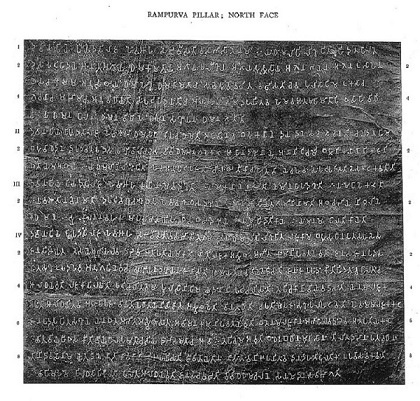
Below are the six edicts in Prakrit (in Devnagari script) authored by Eugen Hultzsch18 in 1925 followed by English translation19: Through these edicts, the Emperor is communicating his moral principles of governance to his subjects. The principles seem to be very novel and very modern for the period he ruled.
➤ FIRST PILLAR-EDICT: RAMPURVA
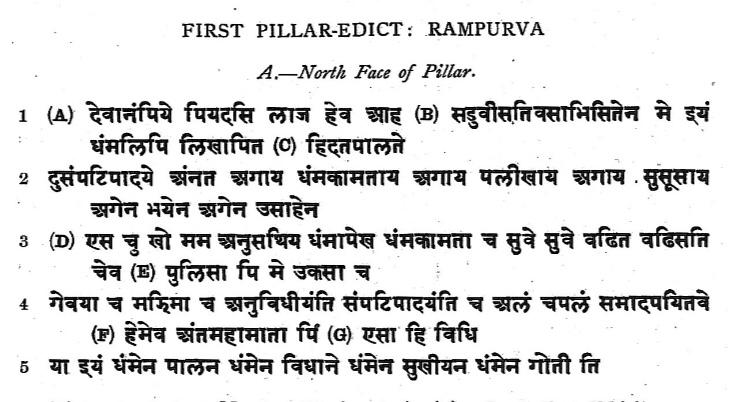
Thus speaks the Beloved of the Gods, the king Piyadassi:
When I had been consecrated for twenty-six years, 1 had this inscription of Dhamma engraved.
It is hard to obtain happiness in this world and the next without extreme love of Dhamma, much vigilance, much obedience, much fear of sin, and extreme energy.
But, through my instructions, care for Dhamma and love of Dhamma have grown from day to day, and will continue to grow. My subordinates too, whether high or low or of middle station, endorse it and practise it sufficiently to win over the wavering, and likewise do the frontier official
For this is my principle: to protect through Dhamma, to administer affairs according to Dhamma, to please the people with Dhamma, to guard the empire with Dhamma.
➤ SECOND PILLAR-EDICT: RAMPURVA
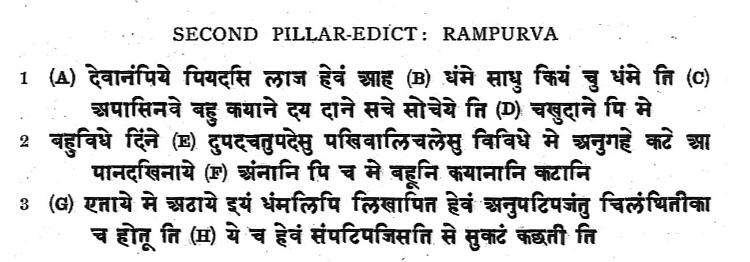
Thus speaks the Beloved of the Gods, the king Piyadassi:
Dhamma is good. And what is Dhamma? It is having few faults and many good deeds, mercy, charity, truthfulness, and purity.
I have given the gift of insight in various forms. I have conferred many benefits on man, animals, birds, and fish, even to saving their lives, and I have done many other commendable deeds.
I have had this inscription of Dhamma engraved that men may conform to it and that it may endure. He who conforms will do well.
➤ THIRD PILLAR-EDICT: RAMPURVA
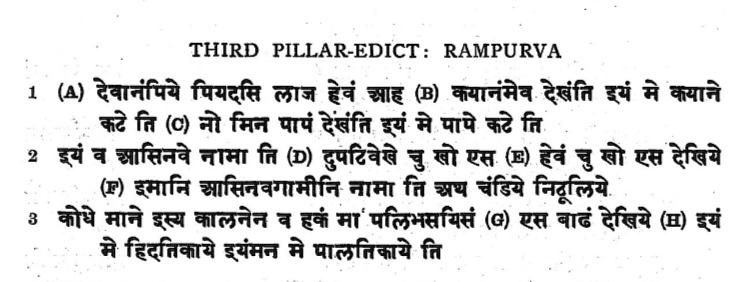
Thus speaks the Beloved of the Gods, the king Piyadassi:
One only notices one’s good deeds, thinking, ‘I have done good’, but on the other hand one does not notice one’s wicked deeds, thinking, ‘I have done evil’, or ‘this is indeed a sin’.
Now, to be aware of this is something really difficult.
But nevertheless, one should notice this and think, ‘Cruelty, harshness, anger, pride, and envy, these are indeed productive of sin.’ let them not be the cause of my fall.
And this one should especially notice, thinking, ‘This is important to my happiness in this world; that, on the other hand, for the next.’
➤ FOURTH PILLAR-EDICT: RAMPURVA
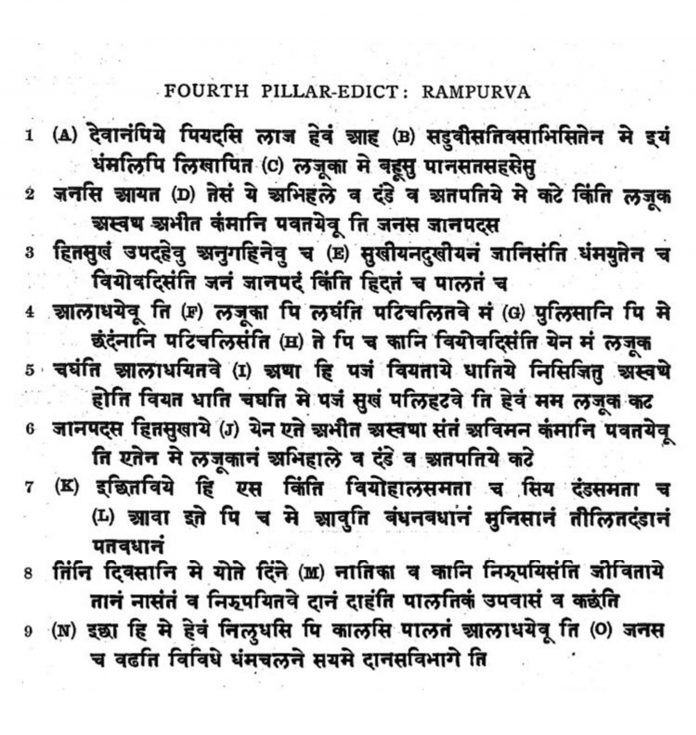
Thus speaks the Beloved of the Gods, the king Piyadassi:
When I had been consecrated twenty-six years, I had this inscription on Dhamma engraved.
My rajukas [rural officers) are appointed over many hundred thousand of people.
In judgment and punishment, I have given them independent authority, so that the rajukas may fulfil their functions calmly and fearlessly and may promote the welfare and happiness of the country people and benefit them.
They will learn what makes for happiness and unhappiness, and together with those devoted to Dhamma, they will admonish the country people that they may obtain happiness in this world and the next.
The rajukas are eager to obey me and they will likewise obey my envoys who know my wishes. These likewise will admonish [the erring rajukas] so that they will be able to give me satisfaction.
Just as one entrusts his child to an experienced nurse, and is confident that the experienced nurse is able to care for the child satisfactorily, so my rajukas have been appointed for the welfare and happiness of the country people.
In order that they may fulfil their functions fearlessly, confidently, and cheerfully, I have given them independent authority in judgment and punishment.
But it is desirable that there should be uniformity in judicial procedure and punishment.
This is my instruction from now on. Men who are imprisoned or sentenced to death are to be given three days respite.
Thus, their relations may plead for their lives, or, if there is no one to plead for them, they may make donations or undertake a fast for a better rebirth in the next life.
For it is my wish that they should gain the next world. And among the people various practices of Dhamma are increasing, such as self-control and the distribution of charity.
➤ FIFTH PILLAR-EDICT: RAMPURVA
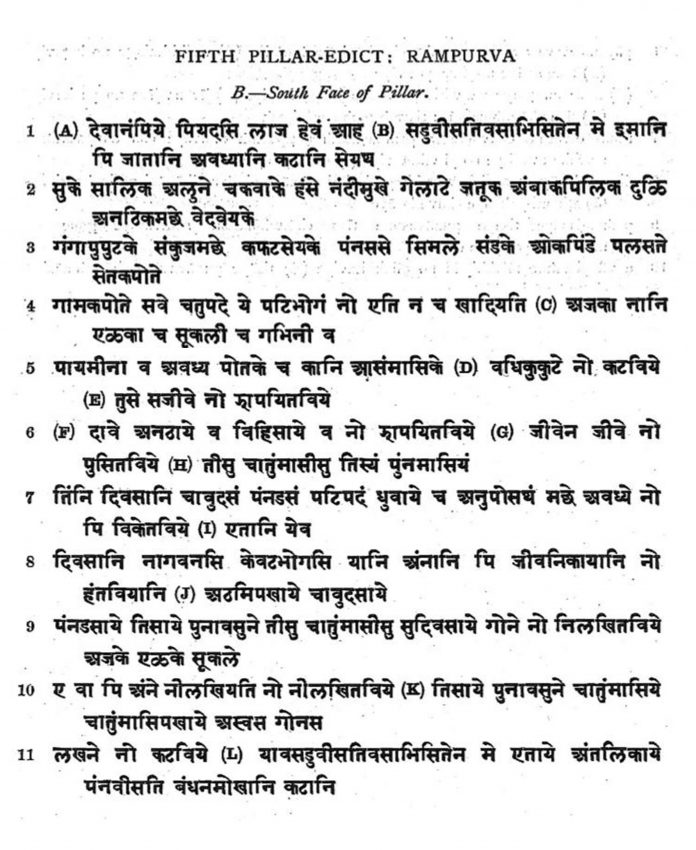
Thus speaks the Beloved of the Gods, the king Piyadassi:
When I had been consecrated for twenty-six years I forbade the killing of the following species of animals, namely: parrots, mainas, red-headed ducks [?], cakravaka-geese, swans, nandi-mukhas [birds encountered in rice fields?], pigeons, bats, ants, tortoises, boneless fish, vedaveyakas, pupulas of the Ganges [fish?], skate, porcupines, squirrels, deer, lizards, domesticated animals, rhinoceroses, white pigeons, domestic pigeon and all quadrupeds which are of no utility and are not eaten.
She goats, ewes, and sows which are with young or are giving suck are not to be killed, neither are their young up to the age of six months.
Capons must not be made.
Chaff which contains living things must not be set on fire.
Forests must not be burned in order to kill living things or without any good reason.
An animal must not be fed with another animal.
On the first full moon days of the three four-monthly seasons, and for three days when the full moon falls on the star Tisya, and the fourteenth and fifteenth of the bright fortnight, and the first of the dark, and regularly on fast days, fish are not to be caught or sold.
And on these same days in the elephant-park and fisheries, other classes of animals likewise must not be killed.
On the eighth, fourteenth, and fifteenth days of the fortnight, on the days of the star Tisya and Punarvasu, on the three first full moons of the four-monthly
seasons, and on festival days, bulls, goats rams, boars, and other animals which it is customary to castrate are not to be castrated.
On the days of the stars Tisya and Punarvasu, on the first full moon days of the four-monthly seasons, and on the fortnights following them, cattle and horses are not to be branded.
In the period [from my consecration] to [the anniversary on which] I had been consecrated twenty-six years, twenty-five releases of prisoners have been made.
➤ SIXTH PILLAR-EDICT: RAMPURVA
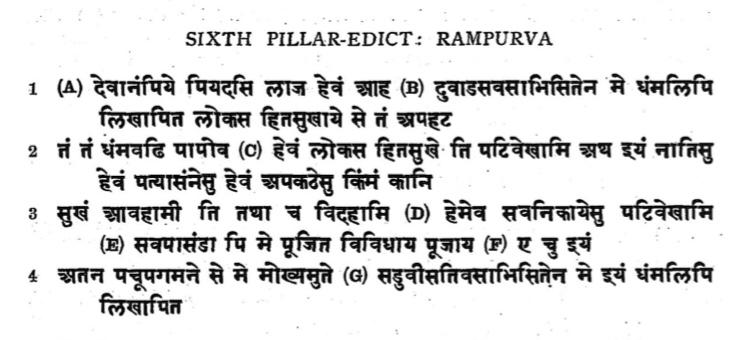
Thus speaks the Beloved of the Gods, the king Piyadassi.
When I had been consecrated for twelve years, I had an inscription of Dhamma, engraved for the welfare and happiness of the world.
Whoever follows it should obtain progress in Dhamma in various ways.
Thus do I provide for the welfare and happiness of the world – in the same way as I bring happiness to my relatives, both close and distant and work for it, so do I provide for all sects.
I honour all sects with various kinds of reverence, and I consider visiting them in person to be most important.
When I had been consecrated for twenty-six years I had this inscription of Dhamma engraved.
____________
HISTORY & PAST EXCAVATIONS:
In modern time, the background for unravelling of the story of Rampurva can be said to set with Alexander Cunningham efforts to map and identify Buddhist structures and monuments based on travel accounts of 6th century Chinese monk Xuan Zang pilgrimage to Nalanda as mentioned in the book ‘The Journey to the West’’ that Cunnigham used to read as a child.
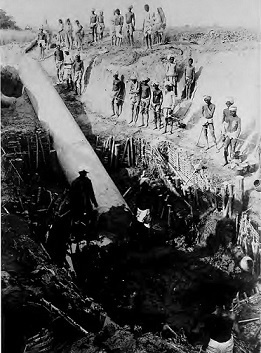
In 1877, Cunningham’s assistant ACL Carlleyle was engaged with archaeological work in Lauria Nanadangarh when some persons from terai came down to him to inform of a similar structure in a village called Rampurwa near Piparia about 37 miles north of Bettiah. He at once thought that that could be another Ashokan pillar in the royal route from Patliputra to Nepal terai. He immediately had an excavation made in the form of trench to find a buried pillar bearing same inscriptions as found in Lauria Nandangarh and Lauria Areraj. A massive copper bolt as well was found meant to fasten the capital. He also found a shattered stone stump about 850 feet south of this find between two mounds but this excavation. This was initially thought to be part of the same pillar but later excavation proved presence of two pillars.
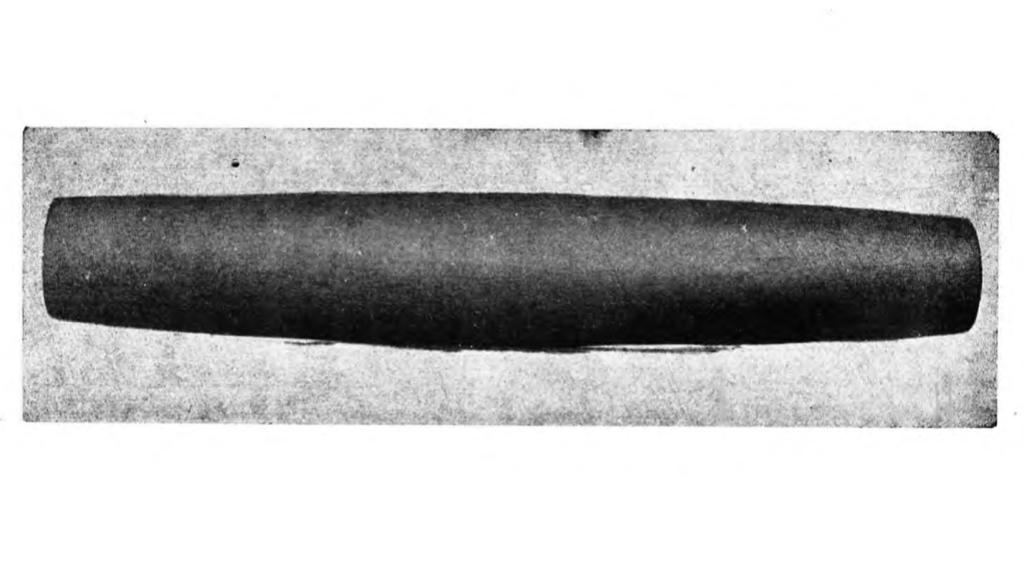
More extensive excavation was carried out in 1907 by ASI under the stewardship of Daya Ram Sahani11 though Garrick had some work after Carlleyle. Lion’s figure that had alluded the previous excavations was successfully found 7 feet below the ground level. Excavation around the stump about 900 feet south of the pillar found by Carlleyle yielded the south pillar and the bull capital. Besides the dilapidated floors around the columns, the team could not find any evidence of building. The two mounds made of yellowish clay on the either side of the south pillar did not yield any human bone, gold leaf or wooden posts to call them sepulchral barrows.
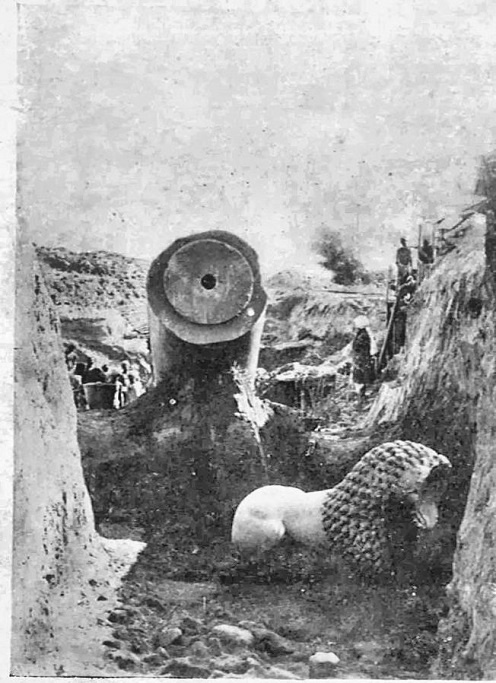
However, the objectives of this excavations were fully met with clear identification of two pillars and the finds of lion and bull capitals. This location still remains the only one to yield two pillars and the bull capital. The considered restoration of the south pillar but found putting three parts together impossible. The capitals were dispatched to the Indian Museum, Kolkata for preservation and the pillars were placed on the mounds under canopy.
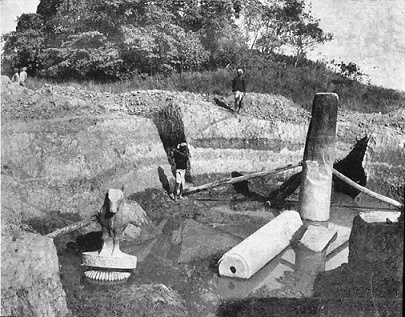
This excavation noted in the report possible importance of the site in view of installation of two pillars but could not find any vestige of building let alone any township.
EPILOGUE & THE WAY FORWARD:
The first archaeological excavation in Rampurva was conducted 145 years ago in 1876 while the last excavation took place in 114 years ago in 1907. These two excavations yielded evidences of presence of two Ashokan pillars at this site (the only site known so far to have twin Ashokan pillars) giving impression that this site must have been an important place. It is in terai on the northern royal highway route from Patliputra to Nepal valley. Emperor Ashoka is known to have visited Buddha’s place of birth and Ramagram stupa in terai. Tracing of footprints of Buddha indicates Rampurva could be the place of Great Renunciation. Some recent analysis, on the other hand suggest it could be the actual site of Buddha’s parinirvana. For Buddhists and Hindus (who consider Lord Buddha to be the ninth reincarnation), these questions are extremely important matters of faith. Affirmative settling of either of the above questions would straightaway make this site second most important Buddhist site in the world with huge tourism potential.
However, the last excavation conducted more than a century ago did not yield any evidence of presence of building or township (though finding such evidence was not the objective). It was conjectured that any such evidence may have been washed away in flood because the region is riparian and notoriously flood prone. But several historic sites in the world suffered such drawback.
The last excavation of 1907 had serious limitations both in terms of mandate and well as in terms of unavailability of modern scientific tools and techniques that are routinely employed these days in archaeological researches including those of sites in riparian and flood prone regions.
***
(Originally published in India Review The Sacred Site of Rampurva in Champaran: What We Know So Far by Umesh Prasad)
REFERENCES:
- Bihar Tourism – Buddhist Circuits. Available at the link
- Sangam R., 2021. Footsteps of Buddha in East and West Champaran. Re-edited by Jagdishwar Pandey. Published by Shangum Mass communication Pvt. Ltd. Available online at the link
- O’Malley 1907. Begal District Gazetteers: Champaran. Available at the link
- Waddell 1886. Tibetan Guide-book to lost Sites of Buddha’s Birth and Death. Available online at the link | pdf file
- Thero MP 2013. Lumbini On Trial: The Untold Story. Available online at the link
- Phelps TA., na. Lumbini On Trial: The Untold Story. Available online at the link
- Anand D., 2020. Evidence suggests Rāmpurwā as the place of Buddha’s Mahāparinirvāṇa. Available online at the link
- Anand D., 2013. Rampurwā- A compelling case for Kuśīnārā- I. Nālandā – Insatiable in Offering. Available online at the link
- Anand D., 2015. Rampurwā a compelling case for Kuśinārā- Part II. Nālandā – Insatiable in Offering. Available online at the link
- Carlleyle ACL 1885. Archaeological Survey of India Report for the Year 1877-78-79 and 80, Published by ASI, GOI, 2000, (First Published in1885). Available online at the link | pdf file
- Sahni, Daya Ram 1907. ASI Report 1907-08 i88. Excavations at Rampurva. Pages 181-188 Available online at the link | pdf file
- Rashtrapati Bhavan, 2020. The Main Building & Central Lawn: Circuit1. – Rampurva Bull. Available online at the link
- Secretariat of President of Inda, 2020. Indian Antiquity: Bull Capital from Rampurva. circa.3rd Century B.C. Available online at the link
- Indian Express, 2013. After 2,200-yr old lion capital damaged at National Museum, staff try cover-up Available online at the link
- Times of India 2014. Central panel to probe Rampurva Lion Capital vandalism today. Available online at the link
- NDTV 2013. Priceless 2000-year-old lion broken at Kolkata Museum. Available online at the link
- Neogi Panchanan 1918. Copper in Ancient India. Available at the link | pdf file
- Hultzsch Eugen 1925. Inscriptions of Asoka. New Edition by E. Hultzsch. Pp 320-325 Available at the link | pdf file
- A Translation of the Edicts of Asoka. (part II). Anonymous. Available at the link
***
RELATED ARTICLES:
- Emperor Ashoka’s Choice of Rampurva in Champaran: India Should Restore the Original Glory of This Sacred Site as Mark of Respect by Umesh Prasad published on 29 June 2020.
VIDEOS:
***
